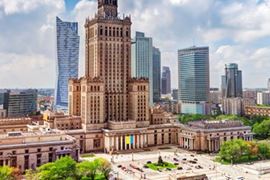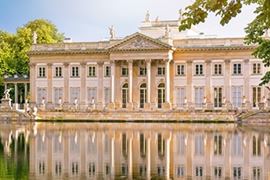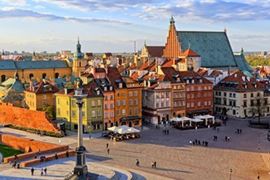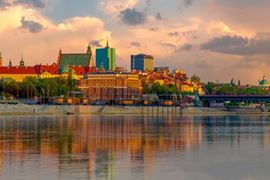Choose one of our Gdansk City breaks and you'll arrive in this Polish city which sits on the Baltic coast of Poland, a port town with an unusually extravagant wealth of fabulous architecture.

Choose one of our cheap Warsaw city breaks and you see what is ranked as one of the most liveable cities in Central and Eastern Europe, Warsaw is a city that has many different attributes making it the ideal candidate for a city break. The capital and largest city in Poland,
Warsaw has a diverse culture with funky, energy thriving club and music scenes battling against the rich, architecturally fantastic buildings and landmarks in the city's Old Town district. Or if that isn't to your taste, join in the fun in some of the street parties, edgy art exhibitions or Chopin-inspired music festivals that regularly fill the bustling streets of the city.
Visit the amazing Royal Castle, King Sigismund's Column or the stunning Market Square as you learn about the city's varied history which has seen it be masterfully re-constructed and re-built from ruins. Experiencing a humid continental climate, Warsaw's weather is similar to that of many European cities – with cold, snowy winters contrasting with warm, bright summers, this is a city that will leave you inspired, amazed and craving another visit!
As the capital of Poland, Warsaw was one of the most beautiful and sophisticated cities in central Europe until it was almost destroyed during the Nazi occupation of World War II. The end of the war saw most of the city reduced to ruins, and large swathes of the population killed or interred in concentration camps. Following this, the buildings in the heart of the old city were meticulously restored during its major rejuvenation project.
Warsaw is divided into two distinct halves by the Vistula River, with the Old Town, the modern city centre, and most of the tourist attractions on the western side. The eastern side of the river comprises mostly uninteresting residential suburbs and business districts.
Today, Warsaw presents a modern urban landscape of high-rise buildings, and the years of communist rule have left an uninspiring architectural legacy of drab concrete structures and uniform prefab-style housing.
Although many people give scant regard to Warsaw as an appealing tourist destination, it is still Poland's largest city and the political, economic, scientific, and cultural hub of the country. It has many museums and historical monuments, galleries, and historic attractions, a variety of restaurants and open-air cafes, and an energetic nightlife.
With green open spaces and classical music concerts, this modern, bustling city is a far cry from the severe communist-era images of post-war Warsaw, which still dominate the global imagination. Visitors to Warsaw will find a resilient and captivating city with lots to offer.
Buses and trams ply the streets from 5am to 11pm each day and are the cheapest way to get around. Tickets are valid for all modes of public transport and must be bought in advance. The metro trains run frequently between the southern suburbs and the city centre and are the fastest way of getting around Warsaw.
Metered taxis can be hailed on the streets or ordered by telephone from a number of different companies; it is best to agree on a price before getting in. Taxis ordered by phone are usually a lot cheaper. Hiring a car is unnecessary except for excursions out of the city. The historic Old Town is best explored on foot and a lovely way to get around the city is provided by the rental bike system.
Warsaw may not have the obvious aesthetic appeal of Krakow, but the city has many hidden historic gems and a meticulously rebuilt Old Town which stands as a tribute to the resilience and determination of its population.
Many of Warsaw's historic sightseeing attractions are clustered in and around Old Town (Starego Miasta), with Market Square at its heart. This part of the city famously rebuilt after the devastation of World War II, is a warren of cobblestone streets and alleys towered over by Gothic and Baroque buildings and palaces, and colourful tiered homes.
The city's best museums can be found in this area, which is best explored on foot. A great way to take in some of Warsaw's best historic sites is to tour the Royal Way, the route stretching from the Royal Castle in Old Town to the King's Palace at Wilanow, which is lined with museums, palaces, and historic buildings, including St Anne's Church.
The graveyards of the city also allow a step back in time: the Jewish Cemetery (Cmentarz Zydowski) is romantically overgrown in summer and spookily snow-covered in winter and is a moving and picturesque site to explore, and the famous Powazki Cemetery is home to some remarkable sculptures and grave markers.
For some outdoor fun go strolling, paddling, and picnicking in the lovely Lazienki Park, the most popular of Warsaw's green lungs. There is a monument to Chopin in the park, which is frequently a venue for outdoor concerts. For those travelling to Warsaw with kids, the Copernicus Science Centre is a great rainy-day attraction.
Warsaw has a humid continental climate, with cold, snowy winters and mild to hot summers. On average, summer (June to August) temperatures range between 47°F (9°C) and 73°F (22°C), while winter (December to February) temperatures range between 25°F (-4°C) and 42°F (6°C). The average temperature in Warsaw is 27°F (-3°C) in January (mid-winter), and 66°F (19°C) in July (mid-summer), although summer temperatures frequently reach 86°F (30°C).
July is the wettest month, although rain does fall sporadically throughout the year; generally rainfall is heaviest in summer, with winter receiving the least rain. Spring (March, April, May) and autumn (September, October, November) are both lovely seasons with pleasant, mild temperatures and plenty of sun, although autumn can be misty.
Warsaw has a long tourist season and the city is lovely to visit any time between April and October. The peak tourist season is summer, especially July and August; however, the city can become unpleasantly crowded. Those who don't mind the cold and snow will find that Warsaw is a great winter destination.
- Jan
- Feb
- Mar
- Apr
- May
- Jun
- Jul
- Aug
- Sep
- Oct
- Nov
- Dec












